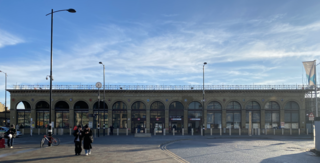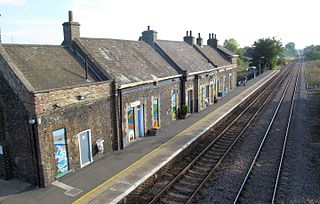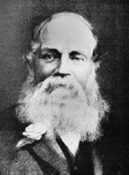
Leopold Redpath (12 May 1816 - 1 May 1891) was a clerk of the Great Northern Railway Company [1] [2] who perpetrated a notorious fraud against his employers and was transported to Australia. [3] [4]

Leopold Redpath (12 May 1816 - 1 May 1891) was a clerk of the Great Northern Railway Company [1] [2] who perpetrated a notorious fraud against his employers and was transported to Australia. [3] [4]

Leopold I was the first king of the Belgians, reigning from 21 July 1831 until his death in 1865.

The Midland Railway (MR) was a railway company in the United Kingdom from 1844. The Midland was one of the largest railway companies in Britain in the early 20th century, and the largest employer in Derby, where it had its headquarters. It amalgamated with several other railways to create the London, Midland and Scottish Railway at grouping in 1922.

Langley railway station is in Langley, a suburb of Slough, Berkshire, England. It is 16 miles 18 chains (26.1 km) down the line from London Paddington and is situated between Iver to the east and Slough to the west. The station is served by local services operated by the Elizabeth line.

The Breckland line is a secondary railway line in the east of England that links Cambridge in the west to Norwich in the east. The line runs through three counties: Cambridgeshire, Suffolk and Norfolk. It takes its name from the Breckland region of Norfolk, and passes through Thetford Forest.

Cambridge railway station is the principal station serving the city of Cambridge in the east of England. It stands at the end of Station Road, 1 mile (1.6 km) south-east of the city centre. It is the northern terminus of the West Anglia Main Line, 55 miles 52 chains (89.6 km) down the line from London Liverpool Street, the southern terminus.

Peterborough railway station serves the city of Peterborough, Cambridgeshire, England. It is 76 miles 29 chains (122.9 km) down the East Coast Main Line from London King's Cross. The station is a major interchange serving both the north–south ECML, as well as long-distance and local east–west services. The station is managed by London North Eastern Railway. Ticket gates came into use at the station in 2012.

Aspatria is a railway station on the Cumbrian Coast Line, which runs between Carlisle and Barrow-in-Furness via Whitehaven. The station, situated 20 miles (32 km) south-west of Carlisle, serves the village of Aspatria, Allerdale in Cumbria, England. It is owned by Network Rail and managed by Northern Trains.

Walsden railway station serves the village of Walsden, Todmorden in West Yorkshire, England, on the edge of the Pennines.

Chippenham railway station is on the Great Western Main Line (GWML) in South West England, serving the town of Chippenham, Wiltshire. It is 93 miles 76 chains down the line from the zero point at London Paddington and is situated between Swindon and Bath Spa on the GWML. The Wessex Main Line diverges from the GWML to the southwest of Chippenham and runs to Trowbridge via Melksham.

Brandon railway station is on the Breckland Line in the East of England, serving the town of Brandon, Suffolk, although the station is actually situated across the county boundary in Norfolk. The line runs between Cambridge in the west and Norwich in the east.
The Rothschild banking family of England was founded in (1798) by Nathan Mayer von Rothschild (1777–1836) who first settled in Manchester but then moved to London. Nathan was sent there from his home in Frankfurt by his father, Mayer Amschel Rothschild (1744–1812). Wanting his sons to succeed on their own and to expand the family business across Europe, Mayer Amschel Rothschild had his eldest son remain in Frankfurt, while his four other sons were sent to different European cities to establish a financial institution to invest in business and provide banking services. Nathan Mayer von Rothschild, the third son, first established a textile jobbing business in Manchester and from there went on to establish N M Rothschild & Sons bank in London.

Frome railway station serves a largely rural area of the county of Somerset in England, and is situated in the town of Frome. The station is located on a 1.5 miles (2.4 km) long branch line which loops off the main line railway, which carries services on both the Reading to Taunton line and Bristol to Weymouth route. Most of the trains which take the loop line in order to serve Frome station are on the Bristol to Weymouth route, and most trains on the Reading to Taunton line by-pass the station on the main line. The station is 22.25 miles (36 km) south of Bath Spa on the Bristol to Weymouth line, it is owned by Network Rail and is operated by Great Western Railway.
Events from the year 1845 in the United Kingdom.

William Welch Deloitte was a British accountant and the founder of the professional services firm that subsequently became Deloitte Touche Tohmatsu in the United States and Coopers & Lybrand Deloitte in the United Kingdom. He was born in London, England. He was one of the fathers of the accountancy profession.

Thomas Chambers Hine was an architect based in Nottingham.
The Northampton and Peterborough Railway was an early railway promoted by the London and Birmingham Railway (L&BR) to run from a junction at Blisworth on the L&BR main line to Northampton and Peterborough, in England. The construction of the line was authorised by Parliament in 1843 and the 47 mile line opened in 1845. The line largely followed the river Nene, and for economy of construction, it had many level crossings with intersecting roads, rather than bridges. In 1846 the L&BR joined with other companies, together forming the London and North Western Railway (LNWR).
The Syston and Peterborough Railway was an early railway in England opened between 1846 and 1848 to form a connection from the Midland Counties Railway near Leicester to Peterborough, giving access to East Anglia over the Eastern Counties Railway. The project was part of the ambition of George Hudson to establish and maintain a monopoly of railway service over a large area of England. The surveying of the line achieved notoriety when Robert Sherard, 6th Earl of Harborough, who was hostile to railways, arranged a battle to obstruct surveys of the proposed line, and later of its construction.
The Norwich & Brandon Railway (N&BR) was the second railway in Norfolk, England, after the Yarmouth & Norwich Railway (Y&NR). Its Act of Parliament on 10 May 1844 authorised it to build a line between Norwich and the small town of Brandon, actually just across the border in Suffolk.

The Cirencester branch line was a five-mile-long single-track branch railway line in Gloucestershire, England that connected Cirencester to the main line at Kemble. It was opened by the Cheltenham and Great Western Union Railway in 1841. The main line was extended from Kemble to a junction near Gloucester in 1845, by the GWR which had taken over the C&GWUR. The branch supported a busy passenger and goods business, but these declined in the 1930s, and closure was threatened in the 1950s. To reduce costs and maintain the viability of the line, lightweight four-wheel diesel railbuses were introduced, and they proved popular. Nevertheless, the line's decline was inexorable, passenger service closed in 1964 and the goods service ending the following year.
Events from the year 1937 in Scotland.